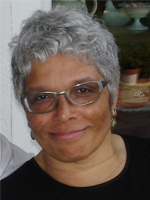
Pat Cummings
Class of 1974, Illustrator, Black Student Union Participant
March 31, 2020
“In ‘68 when we…locked up the campus, we were really going to change things and we had our meeting with the president. We had our list of non-negotiable demands, so I really thought things were going to change…”
Early Education
Pat Cummings arrived at Pratt when she was just 17, having lived on military bases in the United States and abroad, in what she describes as a “protected environment.”
Black Student Union
When she came to Pratt in 1968, she started in fashion and then dropped out because “the revolution started” and she “thought the world was going to change, adding “Kent State had happened, the war was going on and I thought we were really going to make a difference. And it felt like the passion that everyone had was very focused externally on making the world better. It was just such a vivid and vibrant time because everyone cared about making things better. So we had our revolution on campus, and when I left I felt like “Yes, we’re going to continue the revolution, take it worldwide.”
Cummings describes what it was like to be on the campus at the time, when “you could not help but notice that this is an ivory tower in the middle of this neighborhood. And it was like living next door to someone and not noticing the conditions their houses were in, or what condition they were in.” She describes how BSU activists responded: “we brought kids onto campus to eat at the Pi shop. Things like that we considered to be healthy and good change and revolutionary. And we were pretty disruptive.”
Cummings participated in the campus lockout in 1968, when students locked the gates to the campus: ”First of all, everybody wore…we got all of our clothes from Army-Navy stores. Everything was Army and Navy supplies, you know what I mean? So we had military jackets and bellbottoms and we were very, very dedicated and serious. But what I remember was, we were supposed to be patrolling the gates. I was on patrol on one of the gates. I was on the gate on Hall Street, just to make sure they stayed kind of locked. We were going to shut down the school.”
But she also remembers the more formal negotiations with the president and the BSU: “In ‘68 when we…locked up the campus, we were really going to change things and we had our meeting with the president. We had our list of non-negotiable demands, so I really thought things were going to change. I think [the] first thing to alert me that things were not what we thought was when I sat down to negotiate the non-negotiable demands. And I’m thinking that these were non-negotiable.” But she also remembers that some things did change.
“We made some changes. I mean, what we wanted was Black and Latino faculty. There was a whole bulleted list of things that students were demanding, and we were working with the SDS and with the citywide BSU. So there was change.”
A Different Mood in the 1970s
But when she returned to Pratt to finish her degree a few years later, she noted that the administration’s response to the BSU’s demands had diffused the kind of campus activism she had participated in earlier. “The Black Student Union had been given like a large pot of money to write proposals and then it just kind of devolved into what, write proposals? You know? Actually sit down and get some structure. So, you know, we got some structure down but it kind of diffused everything and I think that was on the part of administration.” When she came back in 1973 “it was a different mood, you know, when I got back. And I think across the country it was a different mood because when I came back, there wasn’t that kind of fervor that I remember…”
Career Trajectory
Cummings also describes her experience in Communications Design at Pratt and how she was advised to go into graphic design and not illustration. However, she persisted and eventually became a children’s book illustrator and currently teaches at Pratt.